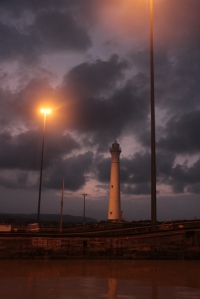It is a feat of engineering that most people in the western world have heard about. As such we were definitely going to visit one of the locks in the Canal as part of our stay in Panama City. That was until we started talking to a friendly boat owner, who was giving us a lift, who suggested doing the whole thing working as crew on someone’s yacht. So we went to Shelter Bay Marina (on the Colon side of Panama) to ask around if there were any boats looking for crew.
We struck gold and found an Irish couple who were in need of a few line handlers. Even better, they sailed on the previous model to my parents’ boat, an Amel Super Marimu, so I was relatively familiar with the set-up. We would be on board the yacht Saol Eile, owned by Paraic and Myra. We swapped details and made tentative arrangements for our departure pending the final assessment from the measurers from the docks, the people who decide on the fee you must pay to transit. The fee covers your boat as well as the necessary pilot who comes on board to help your boat go through the locks. On top of this you have to hire ropes for mooring up against the canal, as most boats won’t have lines long enough, and tyres to protect your yacht.
We arrived on Thursday afternoon ready to help prepare the boat where necessary for our departure on Friday. It was boiling hot, so we were very grateful for having access to a swimming pool in the marina, as well as the super air-conditioned bar, which felt like heaven after being in the sun.
The morning of our departure saw us clearing up the boat, pulling in the dinghy so nothing could get wrapped around it and making the transition of a beautiful sailing yacht into a rather ungainly tug with the use of 18 tyres.
At around 1300 we pushed off, fuelled up at the dock round the corner and then, with a fair amount of trepidation, made our way across the bay towards a waiting anchorage. This was fairly nerve-racking as the bay is full of giant container vessels all measuring over 150m, and it is hard to tell which are moving and which are anchored. Well, since I’m writing this, we obviously succeeded in our goliath’s game of chicken and waited in the anchorage for the pilot to be dropped off. As well as Paraic and Myra there was myself and Stuart as line handlers, Hernando whom they had also hired to help out (a local from the marina who has done the transit a few times) and the pilot who is there purely to give advice.
Once Franklin, the pilot, arrived it was time to make our way towards the first of the three locks, Gatun. As it was the first, I was slightly nervous, not wanting to make any mistakes on someone else’s boat. However we had the benefit of starting to go through during the daylight (we started around 1730). You can select different options for how you would like to be moored in the lock. Saol Eile had requested to go in the middle or rafted up against other yachts. Unfortunately, they ended up rafting with one smaller yacht and a tug, which isn’t ideal as tugs are very powerful vessels and can do a lot of damage to a yacht.
We entered the yacht behind a giant freighter vessel and then started the process of mooring up against the tug. At least this way meant that once lines were attached we didn’t have any work to do, as we were in the middle and it was up to the two outside parties to bring in the lines as the canal level rose. There are three levels to this and by the time we were finished it was dark. But we had completed the first stage and, with a lot of credit to Myra who was helming, I think it all went very smoothly, especially as Gatun Locks in the Colon-Panama City direction of the canal transit is supposed to me the most turbulent due to the inflow of water (the other two have the water level going down).
By that point it was dark, so we made our way into the Gatun Lake to spend the night as small vessels like yachts aren’t allowed to transit during the night. Mooring up was entertaining, as it involved Hernando jumping onto a giant buoy to attach the lines – rather him than me as I would definitely have ended up in the drink. Then it was a pleasant evening celebrating our success so far. We got up at 0530 and waited for our pilot for the next two stages. On arrival it was off with the lines and we made our way through a long winding channel between lush jungle.
 This time around we again rafted up with the smaller Swedish vessel and were going to sit in the middle along with them so we would both be handling the lines. This was definitely better in terms of protecting the boat, but a little more work for the line handlers so it was time to get it right. For the bigger vessels there are trains on tracks that have the mooring lines attached to them and then they go forward with the progression of the vessels between the locks. For smaller boats, you have a coil of rope thrown at you which has a heavy knot at the end to give it propulsion, called a monkey fist. You then attach your lines to this one and send it back to the men on the side. They will then walk your boat into the lock, rather like a big dog, and attach it to the side of the canal.
This time around we again rafted up with the smaller Swedish vessel and were going to sit in the middle along with them so we would both be handling the lines. This was definitely better in terms of protecting the boat, but a little more work for the line handlers so it was time to get it right. For the bigger vessels there are trains on tracks that have the mooring lines attached to them and then they go forward with the progression of the vessels between the locks. For smaller boats, you have a coil of rope thrown at you which has a heavy knot at the end to give it propulsion, called a monkey fist. You then attach your lines to this one and send it back to the men on the side. They will then walk your boat into the lock, rather like a big dog, and attach it to the side of the canal.
By now it was about 1200 and very hot so when the wife on the Swedish boat came up with snacks of sushi and grapefruit we were all very grateful. We had luck on our side as with no wind or current the job went smoothly. This side of Gatun Lake the lock is split into two parts. The first is a single lock, Pedro Miguel. The second is a double lock and one that we would have been to visit and go to the viewing platform, Miraflores. As a second option, going to the Miraflores observation deck isn’t bad. Another one is to go through Pedro Miguel and Miraflores on a tour boat. I don’t like to brag, but it looked like a meat wagon and what was even worse was that the boat we witnessed going through only had little old us to look at and not the container vessels I’m sure the guests were hoping for.
 After those final three locks, we let the Swedish boat go and motored round to an Anchorage that lies just south of the Bridge of the Americas. We spent a last night on the boat and left early the next morning.
After those final three locks, we let the Swedish boat go and motored round to an Anchorage that lies just south of the Bridge of the Americas. We spent a last night on the boat and left early the next morning.
All in all it was definitely an amazing experience and I am very thankful for my sailing experience, which is what gave us the confidence to approach people and offer our services as crew, but saying that, Stuart was great handling the lines so maybe experience isn’t too important. Our hosts were lovely and we had the added bonus of going through the canal on the same sort of boat that my parents will be using to sail through the canal in about a year’s time – gave me a great sense of pleasure.
Alice Bevan









Leave a comment